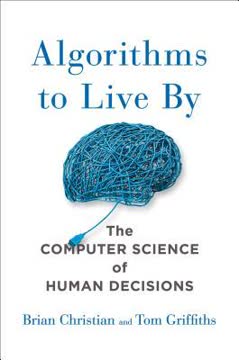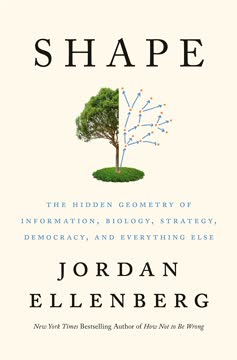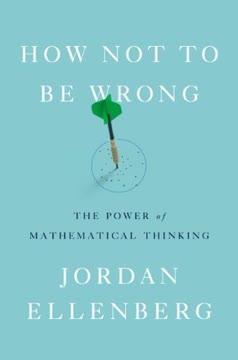Key Takeaways
1. Geometry is everywhere: From pandemic spread to internet searches
Geometry isn't out there beyond space and time, it's right here with us, mixed in with the reasoning of everyday life.
Ubiquitous geometry. Geometry extends far beyond the traditional realm of shapes and angles. It underpins our understanding of diverse phenomena, from the spread of diseases to the organization of internet search results. In epidemiology, geometric models help predict the trajectory of pandemics by analyzing the patterns of transmission. Similarly, Google's PageRank algorithm uses geometric principles to rank web pages based on their interconnectedness.
Real-world applications:
- Disease spread modeling
- Internet search algorithms
- Financial market analysis
- Social network structures
- Urban planning and transportation
This broader view of geometry allows us to see patterns and relationships in seemingly unrelated fields, providing valuable insights and predictive power across various disciplines.
2. The power of trial and error in mathematical discovery
"How do I even start this?" I'm always happy to hear it, no matter how stricken the student looks as they ask, because the question is an opportunity to teach a lesson. The lesson is that it matters much less how you start than that you start.
Embrace mistakes. Mathematics, contrary to popular belief, is not about instant perfection but rather a process of exploration and refinement. Trial and error plays a crucial role in mathematical discovery and problem-solving. This approach encourages creativity, resilience, and deeper understanding.
Benefits of trial and error:
- Develops problem-solving skills
- Encourages persistence
- Leads to unexpected discoveries
- Builds intuition about mathematical concepts
- Mirrors real-world scientific processes
By embracing mistakes and viewing them as learning opportunities, students and researchers alike can tackle complex problems more effectively and make meaningful contributions to mathematical knowledge.
3. Symmetry and perspective shape our understanding of the world
Mathematics is the art of giving the same name to different things.
Power of perspective. Symmetry and perspective are fundamental concepts in geometry that extend beyond mathematics to influence our understanding of the world. Recognizing symmetries allows us to simplify complex problems and uncover underlying patterns. Similarly, changing our perspective can reveal new insights and connections.
Applications of symmetry and perspective:
- Simplifying mathematical proofs
- Understanding physical laws
- Recognizing patterns in nature
- Designing efficient algorithms
- Solving puzzles and brain teasers
By developing an eye for symmetry and the flexibility to change perspectives, we can approach problems more creatively and uncover elegant solutions in various fields.
4. Eigenvalues: The hidden drivers of complex systems
An eigenvalue captures something inherent to the long-term behavior of a system that's not apparent just by looking at it, something latent like the smoke in a leaf.
Unveiling system behavior. Eigenvalues are powerful mathematical tools that reveal the underlying structure and long-term behavior of complex systems. They provide insights into phenomena ranging from quantum mechanics to population dynamics, often uncovering surprising patterns and relationships.
Key applications of eigenvalues:
- Predicting population growth in ecology
- Analyzing vibrations in engineering
- Describing quantum states in physics
- Optimizing search algorithms in computer science
- Modeling economic systems
Understanding eigenvalues allows us to make predictions about system behavior, design more efficient processes, and gain deeper insights into the fundamental nature of various phenomena.
5. Random walks illuminate diverse phenomena in nature and society
Geometry is hiding everywhere, deep in the gears of things.
Unpredictable patterns. Random walks, seemingly chaotic movements governed by probability, provide a powerful framework for understanding diverse phenomena in nature and society. From the movement of molecules to stock market fluctuations, random walk models offer insights into complex systems.
Examples of random walk applications:
- Brownian motion in physics
- Stock price movements in finance
- Animal foraging patterns in ecology
- Diffusion of information in social networks
- Polymer chain configurations in chemistry
By studying random walks, we can make predictions about seemingly unpredictable systems and gain insights into the underlying mechanisms driving various natural and social processes.
6. The geometry of networks reveals surprising connections
The Erdős game for movie stars was invented in the 1990s by a bunch of bored college students who observed that Kevin Bacon had seemingly been in a movie with everyone; he was the Erdős of 1980s and '90s Hollywood.
Interconnected world. Network geometry provides a powerful framework for understanding complex relationships in various fields. By analyzing the structure of networks, we can uncover unexpected connections and patterns that shape our world.
Network geometry insights:
- Six degrees of separation in social networks
- Collaboration patterns in scientific research
- Disease transmission in epidemiology
- Information flow in organizational structures
- Resilience of ecological systems
Studying network geometry allows us to identify key players, predict system behavior, and design more efficient and resilient structures in fields ranging from social sciences to biology.
7. Mathematical models: Balancing simplicity and accuracy
All models are wrong. But some are useful.
Useful approximations. Mathematical models are simplifications of reality that help us understand and predict complex phenomena. The challenge lies in striking the right balance between simplicity and accuracy, creating models that capture essential features while remaining manageable.
Model development considerations:
- Identifying key variables and relationships
- Making appropriate assumptions and simplifications
- Validating against real-world data
- Recognizing limitations and uncertainties
- Iteratively refining and improving
Effective models provide valuable insights and predictive power while acknowledging their limitations. By understanding the trade-offs involved, we can develop and use models more effectively across various disciplines.
8. The interplay of intuition and rigorous proof in mathematics
A proof is crystallized thought. It takes that brilliant buoyant moment of "getting it" and fixes it to the page so we can contemplate it at leisure.
Balancing act. Mathematics thrives on the interplay between intuition and rigorous proof. Intuition guides us towards new ideas and connections, while formal proofs provide the foundation for building reliable mathematical knowledge.
Roles of intuition and proof:
- Intuition: Generating ideas, making connections, guiding exploration
- Proof: Verifying claims, uncovering hidden assumptions, ensuring consistency
- Interplay: Refining intuitions, inspiring new proofs, deepening understanding
Recognizing the value of both intuition and proof allows mathematicians to push the boundaries of knowledge while maintaining the rigor that defines the field.
9. Geometry's role in understanding and predicting human behavior
To talk about the geometry of a space, whether that space is a vial of fluid, the space of market conditions, or a mosquito-ridden marsh, is to talk about how one moves through it—and there seems to be no space in the whole world of geometry where the random walk has not proved an illustrative tool.
Geometric insights. Geometric thinking provides powerful tools for understanding and predicting human behavior across various domains. By mapping behaviors and decisions onto geometric spaces, we can uncover patterns and make predictions about complex social phenomena.
Applications in human behavior:
- Voting patterns in elections
- Consumer preferences in marketing
- Decision-making processes in psychology
- Cultural diffusion in anthropology
- Language evolution in linguistics
Applying geometric concepts to human behavior allows us to develop more nuanced models and strategies for addressing social challenges, from public health interventions to economic policy-making.
Last updated:
FAQ
What's Shape: The Hidden Geometry of Information, Biology, Strategy, Democracy, and Everything Else about?
- Exploration of Geometry's Role: The book delves into how geometry influences various fields, including information theory, biology, and democracy. It emphasizes that geometry is not just about shapes but also about the relationships and structures underlying complex systems.
- Interdisciplinary Connections: Author Jordan Ellenberg connects mathematical concepts to real-world applications, illustrating how understanding geometry can provide insights into everyday life and decision-making.
- Mathematics as a Tool: Ellenberg argues that mathematics, particularly geometry, serves as a powerful tool for understanding and navigating the complexities of the world around us.
Why should I read Shape by Jordan Ellenberg?
- Engaging and Accessible: Ellenberg presents complex mathematical ideas in an engaging and accessible manner, making them relatable to a broad audience. His writing style combines humor with deep insights, making the book enjoyable to read.
- Real-World Applications: The book provides numerous examples of how mathematical concepts apply to real-world situations, from politics to personal decision-making, demonstrating the relevance of math in everyday life.
- Broadening Perspectives: Reading Shape can help readers develop a new perspective on how they view information and relationships in various contexts, enhancing critical thinking skills.
What are the key takeaways of Shape by Jordan Ellenberg?
- Geometry's Ubiquity: One of the main takeaways is that geometry is present in many aspects of life, influencing everything from social networks to biological systems. Understanding these geometric principles can lead to better decision-making.
- Importance of Models: The book emphasizes the significance of mathematical models in predicting outcomes and understanding complex systems. Ellenberg illustrates how models can help us navigate uncertainty and make informed choices.
- Interplay of Math and Reality: Ellenberg highlights the interplay between mathematical theory and real-world phenomena, showing that math is not just abstract but deeply connected to the world we live in.
What are the best quotes from Shape by Jordan Ellenberg and what do they mean?
- “Geometry is the art of reasoning well from badly drawn figures.”: This quote by Henri Poincaré encapsulates the essence of geometry as a tool for logical reasoning, even when faced with imperfect representations. It suggests that the process of reasoning is more important than the precision of the figures.
- “A proof is crystallized thought.”: This quote emphasizes the significance of proofs in mathematics, as they encapsulate insights and make them shareable. It highlights the value of structured reasoning in understanding complex ideas.
- “All models are wrong, but some are useful.”: This quote encapsulates the essence of modeling in mathematics, acknowledging that while no model can perfectly capture reality, they can still provide valuable insights and guide decision-making.
How does Jordan Ellenberg connect geometry to democracy in Shape?
- Gerrymandering Analysis: Ellenberg uses geometry to explain the mathematical underpinnings of gerrymandering, illustrating how shapes of electoral districts can influence political outcomes. He shows that understanding geometric principles can help identify and combat unfair practices in democracy.
- Voting Systems: The book discusses various voting systems and their geometric implications, emphasizing how different methods can lead to different representations of public opinion. Ellenberg argues that geometry can provide insights into creating fairer electoral systems.
- Mathematical Integrity: Ellenberg advocates for the importance of mathematical integrity in democratic processes, suggesting that clear and fair geometric reasoning can enhance the legitimacy of electoral outcomes. This connection highlights the role of mathematics in promoting social justice.
What is the significance of the "random walk" concept in Shape by Jordan Ellenberg?
- Understanding Movement: The random walk concept is used to describe how entities, like mosquitoes or stock prices, move in unpredictable ways. Ellenberg illustrates that this randomness can be modeled mathematically, providing insights into various phenomena.
- Applications in Various Fields: Ellenberg connects the random walk to fields such as finance and biology, showing its relevance in understanding complex systems. This demonstrates how mathematical concepts can transcend disciplinary boundaries.
- Predictive Power: The random walk model helps in making predictions about future states based on past behavior, emphasizing the importance of probability in understanding randomness. This predictive aspect is crucial in fields like economics and ecology.
How does Shape by Jordan Ellenberg address the relationship between geometry and artificial intelligence?
- AI Algorithms: Ellenberg discusses how geometric principles are foundational to many algorithms used in artificial intelligence, particularly in machine learning. He explains that understanding geometry can enhance the development of more effective AI systems.
- Gradient Descent: The book introduces the concept of gradient descent, a method used in machine learning to optimize algorithms. Ellenberg explains how this mathematical technique is analogous to navigating a landscape to find the highest peak.
- Real-World Applications: Ellenberg illustrates the practical applications of AI in various fields, emphasizing that geometry plays a critical role in shaping these technologies. This connection highlights the interdisciplinary nature of modern mathematics.
What is the "Survivor Theorem" mentioned in Shape by Jordan Ellenberg?
- Game Theory Application: The Survivor Theorem is a mathematical principle derived from analyzing the game of Nim, which Ellenberg uses to illustrate strategic thinking. It states that if the number of flags is a multiple of four, the first player loses; otherwise, they can win.
- Proof Structure: Ellenberg demonstrates how to prove the theorem using logical reasoning and tree diagrams, showcasing the importance of structured thought in mathematics. This proof serves as an example of how game theory can inform decision-making.
- Broader Implications: The theorem has implications beyond the game itself, as it encourages readers to think critically about strategy and outcomes in competitive situations. This principle can be applied to various real-life scenarios.
How does Jordan Ellenberg use personal anecdotes in Shape?
- Engaging Narrative: Ellenberg incorporates personal stories to make complex mathematical concepts more relatable and engaging for readers. His anecdotes provide context and illustrate the human side of mathematics.
- Reflecting on Experiences: The author shares his own struggles and triumphs with geometry, allowing readers to connect with him on a personal level. This approach demystifies mathematics and encourages a more approachable view of the subject.
- Encouraging Curiosity: By sharing his journey, Ellenberg inspires readers to explore mathematics themselves, fostering a sense of curiosity and wonder about the subject. His narrative style makes the book accessible to a wide audience.
How does Shape by Jordan Ellenberg redefine the perception of geometry?
- Living Subject: Ellenberg presents geometry as a dynamic and evolving field, rather than a static set of rules. This redefinition encourages readers to see geometry as relevant to contemporary issues and innovations.
- Interdisciplinary Connections: The book highlights the connections between geometry and various disciplines, demonstrating its applicability in real-world scenarios. This approach broadens the understanding of geometry's role in society.
- Emphasizing Beauty: Ellenberg argues that geometry is not just about calculations but also about beauty and creativity. This perspective invites readers to appreciate the aesthetic aspects of mathematical thought.
What is gerrymandering, as explained in Shape by Jordan Ellenberg?
- Manipulation of District Boundaries: Gerrymandering refers to the practice of drawing electoral district boundaries to favor one political party over another. Ellenberg illustrates how this manipulation can distort representation and undermine democracy.
- Mathematical Analysis: The book uses mathematical principles to analyze gerrymandering, showing how geometry can reveal the unfairness of certain districting practices. Ellenberg provides examples to demonstrate the impact of gerrymandering on electoral outcomes.
- Call for Reform: Ellenberg advocates for reforms to combat gerrymandering, emphasizing the importance of fair representation. He argues that understanding the geometric implications of districting can lead to more equitable electoral systems.
How does Shape by Jordan Ellenberg encourage critical thinking?
- Challenging Assumptions: Ellenberg encourages readers to challenge their assumptions about mathematics and its applications. He demonstrates that math is not just a set of rules but a tool for understanding and engaging with the world.
- Interdisciplinary Connections: By connecting math to various fields, the book fosters interdisciplinary thinking. Ellenberg shows that complex problems often require insights from multiple disciplines to find effective solutions.
- Empowering Readers: The book empowers readers to think critically about societal issues, particularly in the context of democracy and representation. Ellenberg provides the tools to analyze and question the systems that govern our lives.
Review Summary
Shape explores geometry's relevance in everyday life, from pandemics to politics. While praised for its engaging writing and accessibility, some readers found it meandering and overly detailed in parts. The gerrymandering chapter received particular acclaim. Opinions varied on the book's structure and focus, with some finding it enlightening and others struggling to follow. Overall, readers appreciated Ellenberg's humor and ability to connect mathematical concepts to real-world issues, though the level of difficulty may not suit all audiences.
Similar Books








Download PDF
Download EPUB
.epub digital book format is ideal for reading ebooks on phones, tablets, and e-readers.





